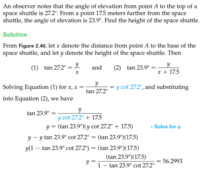You are using an out of date browser. It may not display this or other websites correctly.
You should upgrade or use an alternative browser.
You should upgrade or use an alternative browser.
Can someone prove this
- Thread starter Chris59
- Start date
pka
Elite Member
- Joined
- Jan 29, 2005
- Messages
- 11,974
Frankly, I don't understand your doubt.View attachment 14861 I can verify that it's true, but I don't understand the last step algebraically.
\(\displaystyle \frac{1}{\tan(x)}=\cot(x)\)
Dr.Peterson
Elite Member
- Joined
- Nov 12, 2017
- Messages
- 16,604
I wonder if people are misunderstanding your question, because you omitted the context.View attachment 14861 I can verify that it's true, but I don't understand the last step algebraically. Thanks
I think that what you showed us here is part of a solution you were given, and you are asking why they wrote the last bit, which is in blue. Am I right that "the last step" refers to the blue part?
If so, then post #2 answers it. The reciprocal identify says that [MATH]\cot(x) = \frac{1}{\tan(x)}[/MATH]. Consequently,
[MATH]\frac{y}{\tan(27.2)} = y\cdot \frac{1}{\tan(27.2)} = y\cdot \cot(27.2)[/MATH],
as they say.
If that's not what you mean, please ask your question a different way, in case we're all being dense.
I wonder if people are misunderstanding your question, because you omitted the context.
I think that what you showed us here is part of a solution you were given, and you are asking why they wrote the last bit, which is in blue. Am I right that "the last step" refers to the blue part?
If so, then post #2 answers it. The reciprocal identify says that [MATH]\cot(x) = \frac{1}{\tan(x)}[/MATH]. Consequently,
[MATH]\frac{y}{\tan(27.2)} = y\cdot \frac{1}{\tan(27.2)} = y\cdot \cot(27.2)[/MATH],
as they say.
If that's not what you mean, please ask your question a different way, in case we're all being dense.
 Here is the entire problem in question. I understand every other aspect of it. I also am aware of the Trigonmetric identity cotangent = 1/tangent, but that's not what's stated in the line "solving Equation (1)." Replacing y with a constant yields an equality, but I just don't know how. Thanks for your help guys.
Here is the entire problem in question. I understand every other aspect of it. I also am aware of the Trigonmetric identity cotangent = 1/tangent, but that's not what's stated in the line "solving Equation (1)." Replacing y with a constant yields an equality, but I just don't know how. Thanks for your help guys.